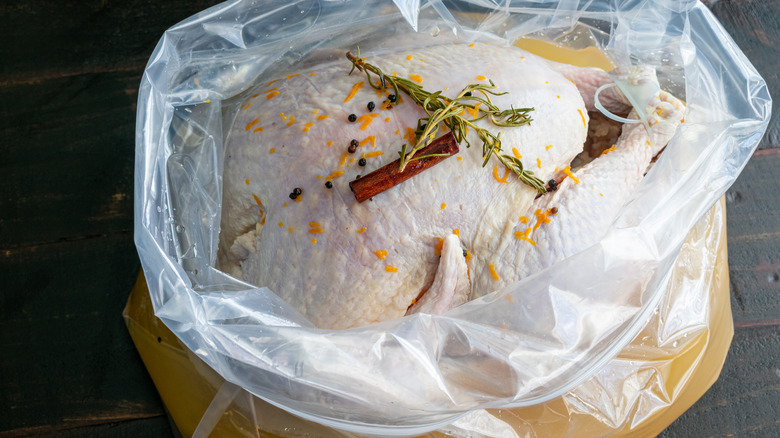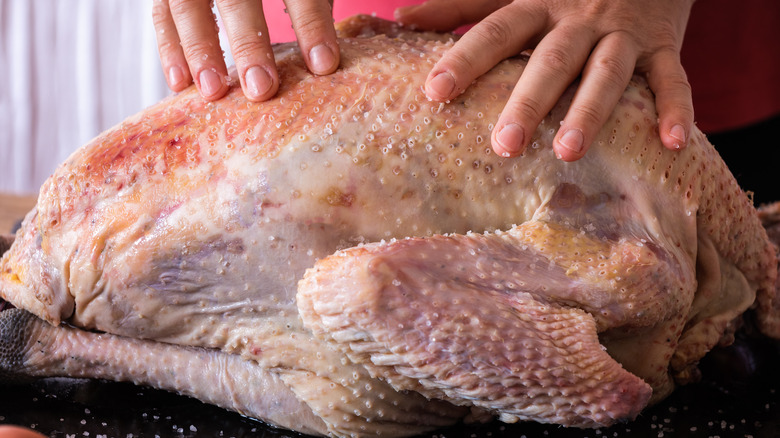Why Ina Garten Prefers Dry Over Wet Turkey Brine
Towards the end of the year, there's a lot of talk about brining turkeys, but the chatter dies down after the New Year when we tend to roast the bird less and less for dinners or gatherings. However, brining is a process that can benefit any lean protein, including chicken, fish, and pork, so it doesn't need to be seasonal.
If you struggle with dry turkey meat, brining (and gravy) may be the fix. When Ina Garten was asked on "Today" how she prepares her roast turkey, she took a hard stance on the topic. According to the beloved chef, the benefits of dry and wet brining are similar, but in her opinion, dry is much easier.
Wet brining involves submerging the protein entirely in liquid, which flavors the meat and changes its texture. The bird absorbs the solution, leaving the poultry flavorful and moist despite being cooked for hours.
While wet brining is manageable with chicken parts or a pork roast, which don't take up much space, making room in the refrigerator to brine a 15-pound turkey can be tough, especially during the holidays when the fridge is stocked with ingredients. A 5-gallon plastic bucket, stainless steel pasta pot, or enameled Dutch oven is needed to hold the meat and brining solution, requiring you to empty the refrigerator and remove a shelf.
This is partly why Garten prefers to dry brine when preparing her turkey, while also coating the meat with fresh thyme, lemon zest, and kosher salt. This process doesn't require additional space, making it preferred for many cooks.
The difference between wet and dry brining
If you're considering brining a turkey, there are additional factors to consider to determine which method is best for you, like how much time you have. Wet brining impacts the protein quicker than dry but the seasoning needs to dissolve in hot water and cool before being added to the turkey. To expedite this step, try a pickle juice brine. As little as 30 minutes is needed for boneless chicken cutlets, and up to a day for an entire turkey. If you don't have a container large enough to submerge the turkey fully, you'll need to turn the meat occasionally.
Dry brining is more hands-off. Once the turkey is coated in salt, it doesn't require attention until it's time to cook. However, dry brining requires more time for the salt to penetrate the skin and tenderize the meat. Salting the turkey's exterior over two to three days will evenly distribute the seasoning throughout the bird whereas an hour of salting will season the skin but won't impact the meat.
One of the downsides of wet brining is that the additional moisture affects the skin, leaving the fully cooked turkey pale and soggy. To get a golden brown, crispy exterior, you should allow the turkey to dry out on a sheet pan overnight. Moisture is the enemy of caramelization, and the refrigerator's cool, dry atmosphere will help dehydrate the surface, making it easier to brown.
How to dry brine
When Ina Garten dry brines a turkey, she prepares it three days in advance. The poultry is dried well with paper towels before being coated in a few tablespoons of kosher salt, thyme, and lemon zest. She works the seasoning into the skin and reserves roughly 1 tablespoon of dry brine for the turkey cavity, ensuring the meat is seasoned inside and out. Dry brines should include salt, but otherwise, feel free to experiment with other seasonings and sweeteners.
Garten wraps the bird tightly in plastic, which prevents cross-contamination, but other cooks leave it uncovered on the bottom shelf away from ready-to-eat food. Instead of needing a giant pot, the turkey is placed in a shallow pan so air can freely circulate. Garten removes the plastic wrap the day before cooking so the skin can dehydrate in the refrigerator overnight.
It may seem like a lot of salt, but Garten assures home cooks that the meat isn't salty, just really flavorful. In fact, when it's time to roast the turkey, she coats the room-temperature bird in softened butter and adds more kosher salt to the skin.
You can apply this technique to other lean proteins, too, adjusting the brining time. Try dry brining pork chops for a golden brown crust without overcooking the meat. Add gochujang and sesame seeds to kosher salt for a Korean-inspired dish, or coat the lean protein with Mediterranean herbs like rosemary and fennel.



